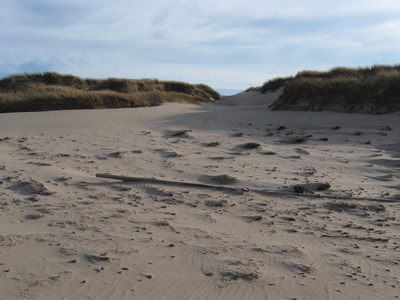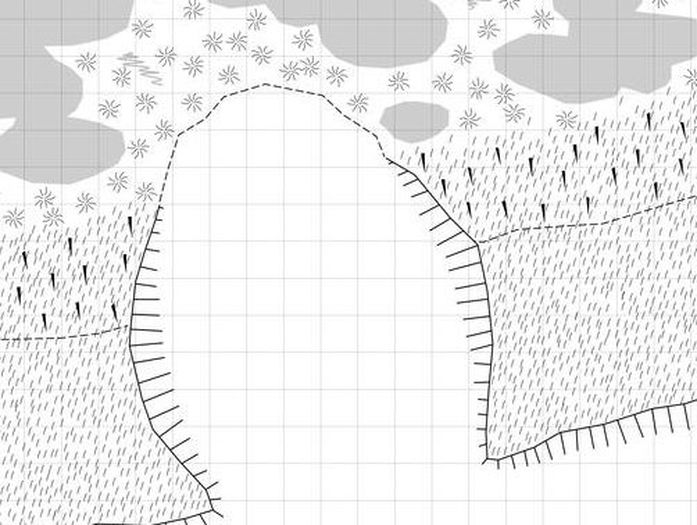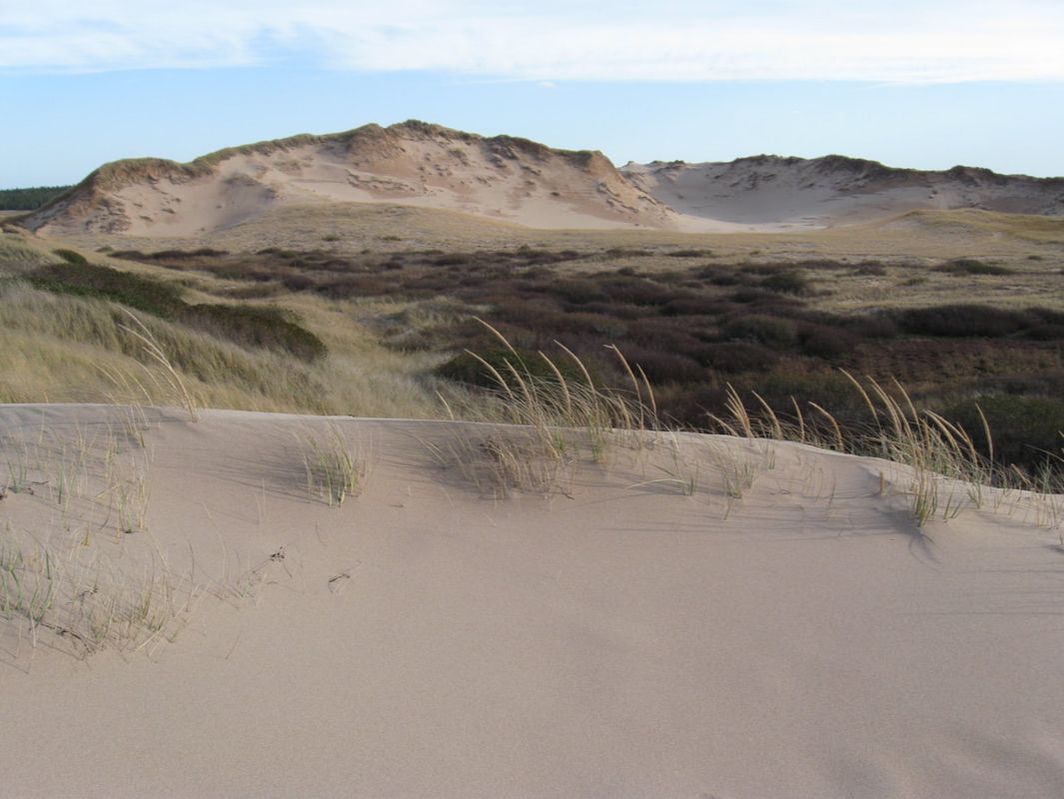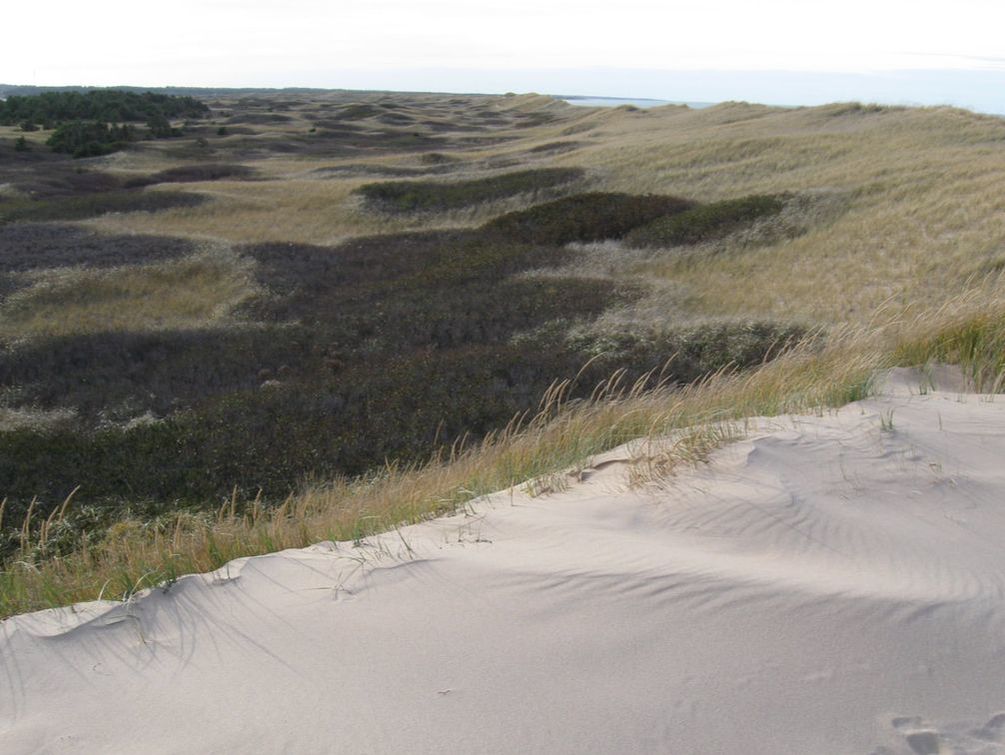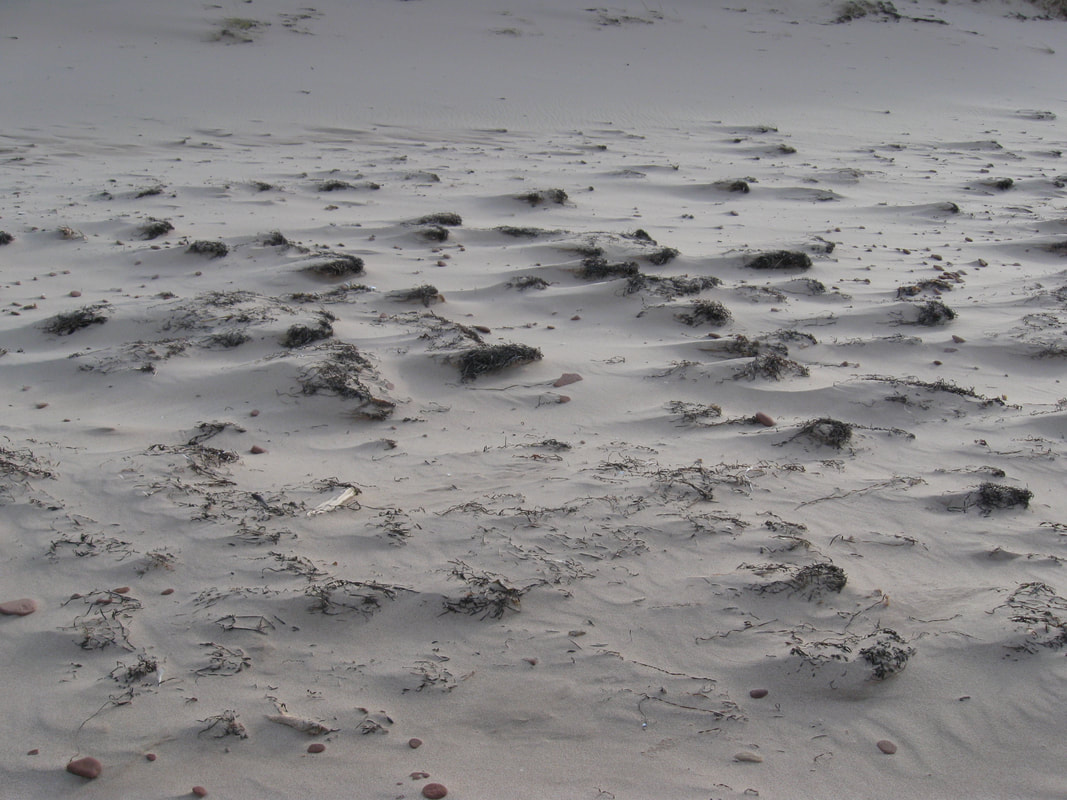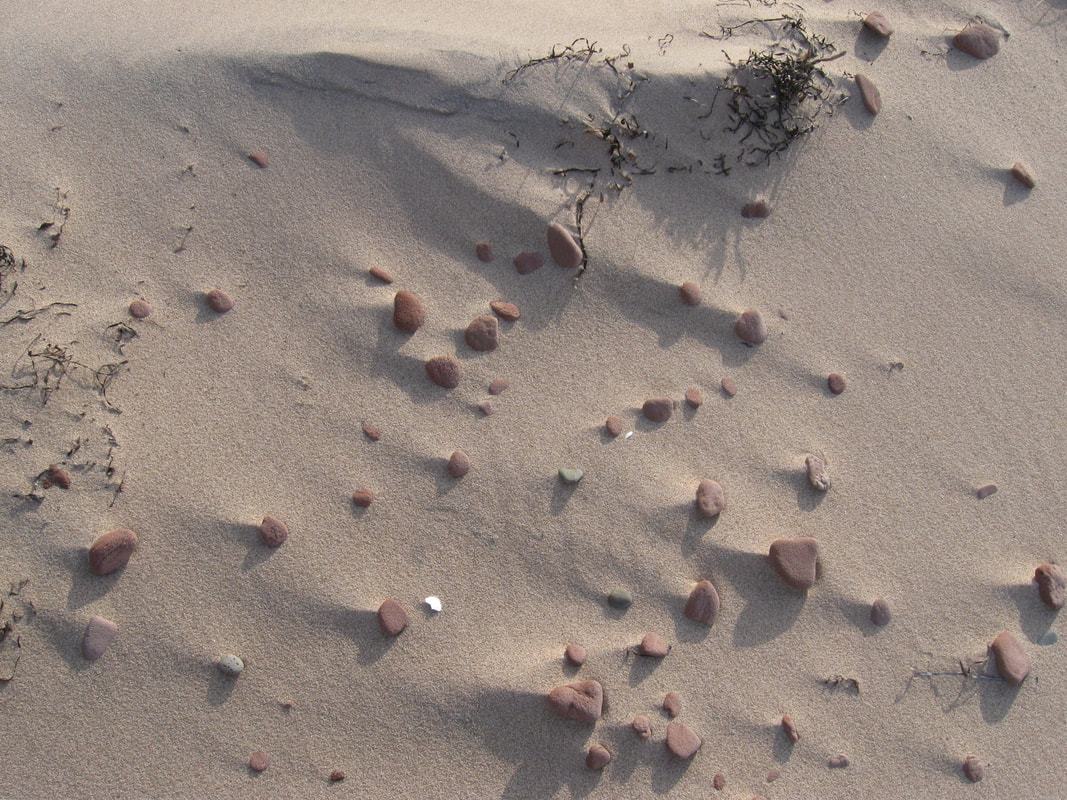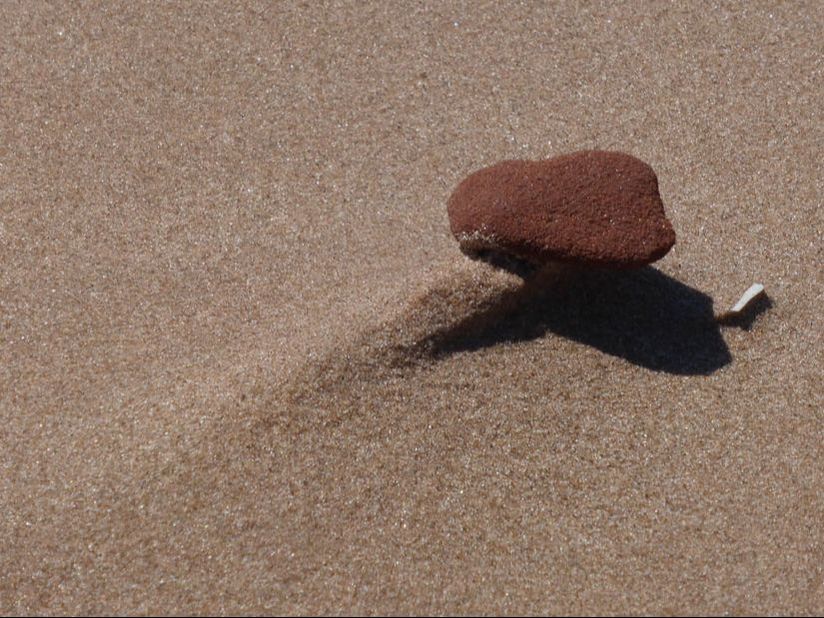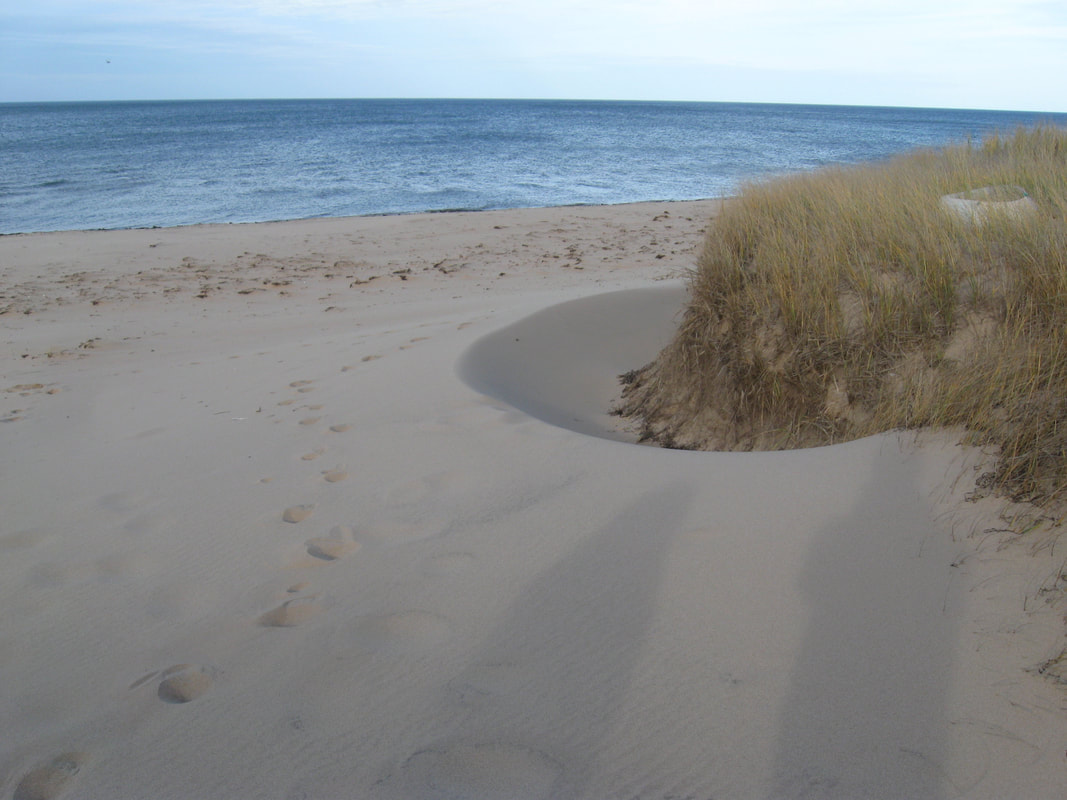A line of grass-covered, beachfront dunes is broken by a wind-cleared basin of bare sand. There is still a dune top ridge here, but it has pushed further inland than the stable dune lines to either side, extending a small distance over the wetland behind the dunes.
Dimensions The grassed-over dune ridge is 40 feet (12 m) across and about 15 feet (5 m) high. The bare sand basin of the blowout extends 50 feet (15 m) back from the dune front, and is 40 feet (12 m) wide. The bottom edge of the sketch map faces toward the shore edge, and the top edge faces inland. Solid comb lines mark steep eroded drop-offs at dune fronts and sides, light dashed lines mark sand ridge crests, and black arrows pointing upslope indicate the steep back face of the dune line. White areas indicate bare sand, and the parallel-dash pattern marks grass-covered dune surface. In the wetland zone at top of the map, indicated by a radial tufts-of-grass pattern, gray areas mark low bushes and gray squiggles mark areas of visible standing water a few inches/centimeters in depth. Overlay grid squares are five feet (1.5 m) across. (A larger-area version of this map is available for download on the FOR GAME MASTERS page.)
Key Details
- Origin: sand blown off the beach has accumulated over centuries to create the dune line, and that sand would continue to be blown inshore except for the grass turf that anchors it in place. Heavy foot traffic across a point on the dune crest can kill grass and break up the turf, letting the wind quarry away the sand, creating a bare depression that breaks the dune line. At the basin edges, free wind erosion of the exposed sand will undercut edges of the remaining turf, expanding the area of the blowout depression as years go by.
- Winds here typically blow from sea to shore in the day, and (less strongly) from land toward the water at night. At ground level, wind will converge to flow more strongly through the blowout gap in the dune ridge, encouraging even more sand to erode there.
- The grassy tops of the dunes, sloping gently toward the sea, are somewhat irregular in height. The fronts of the dunes have been eroded by strong winter waves, making a steep, bare drop-off between dune and beach. Even higher eroded faces of bare sand are found on the sides of the blowout.
- At the inland edge of the blowout the low, sharp ridge shows bare sand on the basin interior side, and is grassed over on the outer, landward side. Standing here, one can look out over the flat marshy ground toward even larger dunes further inland, and look to either side along the steeper back sides of the dune ridge.
- The wetland ground is spongy underfoot, and partly covered by dark knee-high to waist-high bushes that can be stepped across at a slow pace. A great variety of shore birds and rodents nest here, hunted by foxes.
- The wetland is here because the beach and shore dunes actually make up a shore-parallel peninsula of sand carried along the shore by waves over millenia, partly enclosing a brackish water bay whose shallow margins have become marsh and expanses of somewhat more solid, seasonally wet ground.
- The floor of the blowout basin is scoured by wind, but also sometimes built up by sand blowing in from the beach. In times of erosion, any small object on the sand surface can hamper the removal of the grains by wind. Clumps of dried seaweed encase small mounds of sand, and pebbles can stand elevated on small pillars of protected sand. Any such tiny obstacles to the wind may have small 'tails' of slightly higher, ridged sand running off in the downwind direction (on a still day, these tails will indicate the most recent direction of strong winds through the gap).
- One detail feature created by wind sculpture on the edge of the blowout is a bathtub-sized, curved trench running just below a corner of the remaining grass-stabilized dune surface. Air turbulence next to this steep rise keeps its loose sand base hollowed out.
Story Elements
- The blowout could be a place to hide from someone walking down the coast along the beach, which otherwise provides unobstructed long-distance views along the shoreline. It might be a place for a wandering member of one's group on the beach to suddenly be out of sight.
- This basin-shaped gap makes a natural meeting place for negotiation between inhabitants/users of wetlands and ocean.
- On later afternoons of scorching days, shadow cast below one of the dune-edge drop-offs will be a welcome place to get out of the sun.
- Someone who has been walking the beach for miles along the coast might suddenly realize, with a look through the blowout gap, that there is now wetland/bay in back of the dunes, not more solid ground. An easy way to walk inland is now missing.
- A small object (jewelry, coin, metal button, etc.) left on the blowout floor may stand out in relief days after. The foreign object may also be the tip of something larger that is still buried.
- Because this spot is out of the ordinary and looks sheltered, it might be chosen as a place to pitch a tent. Beyond continual sounds of waves, breeze, and sea birds, someone in the tent during active winds may may hear thrumming of strings and fabric, the hiss of blowing, bouncing sand, and light pattering of sand grains against the tent exterior. Light sand drifts may accumulate around parts of the tent overnight.
- For someone new to the experience of a night inside a tent, the severely limited view of the outside yet with full exposure to its sounds can make for some odd and uncomfortable experiences: sudden flapping of wings close by, disturbing cries from who-knows-what-kind-of-creature, muffled footsteps on the sand that pause for an uncomfortable interval, or scattered raindrop sounds on the tent fabric belied by a step outside into an entirely dry morning.
- Much of the beach surface is removed and replaced each year by wave action. On the other hand, something buried in the dunes may lie there physically undisturbed for centuries (although it will continue to be exposed to the air and wetted by quickly infiltrating rainwater, beneath the sand). As a blowout expands in size, objects buried in the dunes to either side may be exposed in the eroding sand walls.
- Characters using teleportation or some mystical portal to land on the exact coordinates of a spot on the dunes that hasn't been visited for some years or decades, may have a surprise waiting on arrival. They might materialize in mid-air and drop several yards/meters to the floor of a blowout that has developed since last visit. This could be a quite probable outcome if, in times of the spot's earlier visitation, there had been quite a lot of foot traffic or unwise clearing of the ground there.
- Combat Dynamics:
- The dune crest makes a natural defense line, providing higher-elevation advantage for those occupying the dune tops, and also giving some protective cover behind the grassy crest for occupiers on the landward side. Attackers from the sea will be slowed as they attempt to climb the eroded drop-off faces of the dune fronts. In any of these circumstances, the blowout gap makes a natural focus for combat, as a low breach in the barrier.
- In melee combat, seaward-side defenders on the dune crests will have the steep drop-off to the beach at their backs, hampering opportunity for orderly retreat.
- The inland rim of the blowout is high enough to provide cover for ranged-weapon fighters kneeling or lying on either side of the low ridge (although either side will be fully visible to observers up on the the nearby crest of the dune line). Because the inland rim extends a few yards/meters out onto the wetland, sharpshooters on the seaward side of that rim will command a 200 degree unobstructed view over the wetland flat and the back slopes of the dunes.
- Attackers from the seaward side, attempting to rush through the gap, may find an array of defenders crouching with ranged weapons on the far side of the inland rim. Attackers running through the center of the blowout will be worst off, subjected to crossfire from front, left, and right. It will be best to crowd to the left or right of the gap, out of view of some snipers and with shorter distance to reach and overrun the rim.
- On a day with high winds blowing inshore, landward-side defenders crouching behind the blowout's inland rim will have sand blowing in their faces, and therefore be distracted and momentarily blinded during intense wind gusts.
- The dune crest makes a natural defense line, providing higher-elevation advantage for those occupying the dune tops, and also giving some protective cover behind the grassy crest for occupiers on the landward side. Attackers from the sea will be slowed as they attempt to climb the eroded drop-off faces of the dune fronts. In any of these circumstances, the blowout gap makes a natural focus for combat, as a low breach in the barrier.
Reference Location
Prince Edward Island National Park, Greenwich Dunes Area, northeastern Prince Edward Island, Canada. Access to the western beach and shore dunes is through a several-mile/km network of hiking trail over rolling ground and wooden walkways over the marsh.
© Rice-Snows 2018
Proudly powered by Weebly

